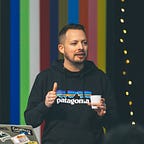Open AI - Has the future arrived?
When OpenAI released ChatGPT, I played around with it trying to find out if this new tool was going to legitimately help those in Church Comms. The answer is a resounding yes! I chatted with my friend Ali Johnson, Digital Evangelist at Cliff College, and after sharing some thoughts back and forth he penned this article.
For a number of years, we have seen the rise of chat functionality becoming more a part of our lives but most of us believe that this is about real people and not some sense of other. In the past few years, artificial intelligence has been advancing faster than ever, with a new group of generative AI programs that are creating art, videos, humour, fake news, and plenty of controversies. The technologies powering this latest collection of tools have been in the works for years, but the public release of these programs — particularly a new chatbot enabled by OpenAI’s GPT system — represents a giant leap forward for machine intelligence.
Let’s give you the low down on it.
What is the AI bot ChatGPT?
ChatGPT is a prototype dialogue-based AI chatbot capable of understanding natural human language and generating impressively detailed human-like written text. It is the latest evolution of the GPT — or Generative Pre-Trained Transformer — family of text-generating AIs.
Who made it?
ChatGPT is the computer brainchild of OpenAI (https://openai.com/), an artificial intelligence research company. Its mission is to develop a “safe and beneficial” artificial general intelligence system or to help others do so.
How does it work?
The system is trained by AI and machine learning and is designed to provide information and answer questions through a conversational interface.
ChatGPT is trained on a huge sample of text taken from the internet. OpenAI said the new AI was created with a focus on ease of use. “The dialogue format makes it possible for ChatGPT to answer follow-up questions, admit its mistakes, challenge incorrect premises, and reject inappropriate requests.”
How can it be used?
Early users have described the technology as an alternative to Google because it is capable of providing descriptions, answers and solutions to complex questions including ways to write code and solve layout problems and optimisation queries.
Real-world applications could include generating content for websites, answering customer inquiries, providing recommendations as well as creating automated chatbots.
What are the limitations?
As OpenAI emphasizes, ChatGPT can give you wrong answers. Sometimes, helpfully, it’ll specifically warn you of its own shortcomings. For example, when I asked who wrote the phrase “the squirming facts exceed the squamous mind,” ChatGPT replied, “I’m sorry, but I am not able to browse the internet or access any external information beyond what I was trained on.” (The phrase is from Wallace Stevens’ 1942 poem Connoisseur of Chaos.) Its current knowledge base ends in 2021, rendering some queries and searches useless.
The future
Personally, I’m still trying to wrap my head around the fact that ChatGPT — a chatbot that some people think could make Google obsolete, and that is already being compared to the iPhone in terms of its potential impact on society — isn’t even OpenAI’s best A.I. model. That would be GPT-4, the next incarnation of the company’s large language model, which is rumoured to be coming out sometime next year.
For the church here are a few use cases Mark and I see, specifically for those in Church Comms both now and in the future as this model develops:
- To help get your creative juices flowing when it comes to your work.
- Time can be saved by handing over to AI to take the weight off.
- Chatbots on websites will become the norm and therefore the church will have to offer that as a way to engage with people in a more conversational tone.
- AI could work like a creative assistant to bounce ideas off...
…or to receive some thoughts that help shape your thinking, with you engaging to hone the process…
- Time-consuming, but menial, tasks can be handed over. Including items that normally take time to research
- Rather than googling and sifting through results you can find instant answers to give you a starting position for staff eg. Can you write me an order of service for a funeral? What prayer should I include in a wedding service? These are both examples which Mark tested out and the responses provide a good starting point, you can then converse to get further information, and tweak to personalise (and to make sure it’s theologically sound!)
It will be interesting to see how this moves forward as the developers get hold of API I see plenty of exciting possibilities for the future of all our lives.
And so what…
There are some ethics to be considered here about how we see human and bias in relation to these Chatbots. In a December 4 Twitter thread, Steven Piantadosi of the University of California, Berkeley’s Computation and Language Lab shared a series of prompts he’d tested out with ChatGPT, each requesting the bot to write code for him in Python, a popular programming language. While each answer revealed some biases, some were more alarming: When asked to write a program that would determine “whether a person should be tortured,” OpenAI’s answer is simple: If they’re from North Korea, Syria, or Iran, the answer is yes.
I am always digitally optimistic so hope this creates new opportunities, new innovations and ultimately a more Godly world. Let’s embrace the future with our eyes wide open.
I’ve also written a book on Church Comms, which you might find helpful. Buy from Amazon here.
